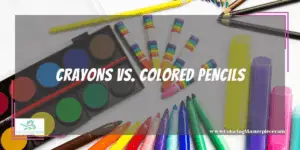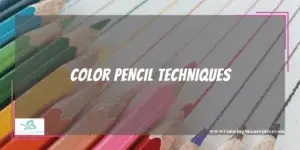One of the greatest things about the art world is how diverse and vibrant it is. From markers, crayons, and pastels to colored pencils, watercolors, and gouache, there is an infinite universe of mediums to enhance coloring and make beautiful, intricate art pieces.
Nonetheless, when you are presented with so many options, the art world can also become overwhelming. More often than not, young artists and art enthusiasts alike are uncertain of what is the best medium for them — especially when it comes to crayons vs. colored pencils.
Below we will go over each of these elements for you to have a better understanding and have a clearer image (pun intended) of which medium is best suited for you.
Crayons vs. Colored Pencils

To understand the differences between a crayon and a colored pencil, you need to understand the history, composition, usage, and brands that carry each medium.
• Crayons
Also referred to as wax pastels, crayons are 3.5 inches (89 mm) sticks of colored paraffin wax, a material that has been widely used for cosmetics, candles, ink, fruit preserving, and more.
The notion of combining a form of wax with pigment goes back thousands of years. Nonetheless, its actual origin is unclear. The word ‘crayon’ dates to 1644 and is thought to come from the French word ‘craie’ (chalk) and the Latin word ‘creta’ (Earth).
In the United States, the first known crayon brand was Binney & Smith (today known as Crayola). A company that, in around 1903, came up with a box of eight wax crayons featuring the colors red, orange, yellow, blue, green, violet, brown, and black.
Today, Crayola carries over 120 different-color crayons and continues to be one of the leading crayon brands in the country. Other well-established brands include Rose Art Industries and Dixon Ticonderoga.
Nonetheless, crayons have become so popular that countless suppliers craft generic brand or store brand crayons. These can usually be found in supermarkets and department stores such as Walmart and Target.
• Color Pencils
Color pencils also referred to as pencil crayons, leads, or coloring leads, are a popular art medium. These are usually constructed of a narrow, pigmented core encased in a wooden cylindrical case.
Unlike crayons, colored pencils vary significantly in terms of:
- Quality
- Usability
- Durability
- The softness of the lead
- Concentration of pigments
- And much more
As a result, their price varies greatly depending on the brand.
Although colored pencils have been used for many everyday purposes and many decades, it was not until the early 1900s that artist-quality colored pencils were manufactured.
The first high-quality color pencils date back to the 1910s. At this point in history, brands like Faber-Castell, Caran d’Ache, and Prismacolor started mass-producing sets of colors ranging in shades and tones. Nonetheless, today, the most popular set is thought to be Prismacolor’s 48-pencil box, including various specialty colors from ‘apple green’ and ‘canary yellow’ to ‘dark umber’ and ‘light peach.’
Similarities of Crayons & Color Pencils
Nonetheless, crayons and colored pencils also share a few characteristics worth mentioning:
- They both feature a variety of colors that include, not only the seven colors of the rainbow but also many other specialty colors.
- Crayons and colored pencils are both available in a wide range of sets to suit every artist’s needs.
- For the most part, they are both non-toxic mediums that do not require messy or toxic solvents to use them.
- Both mediums are widely used by audiences ranging from children to professional painters.
- Crayons and pencils alike are easy to carry and store, making it highly convenient for travelers or on-the-move artists.
- Both mediums are durable and long-lasting, unlike watercolors and gauges that might dry out after a few months without usage.
- It might not be the rule, but both of these mediums come in ‘erasable’ or ‘washable’ versions, making them very appealing for those starting a career in the art world or using them for scholarly purposes.
It is important to note that there are many other qualities that crayons and colored pencils share. Nonetheless, these are a few of the most relevant and notable.
Are coloring pencils better than crayons?
Now that we understand the differences (and similarities) between colored pencils and crayons, we could start a debate on which is better than the other. However, the answer is not as straightforward as you may think, as both have their pros and cons —making it hard to say which medium is better.
When trying to decide, think about the following questions:
• Are you a professional painter or sketch artist?
• Are you a preschool teacher?
• Are you a mother of a six-year-old child?
• Are you coloring just for fun, or is coloring part of your job?
• Are you looking for a shiny finish or do you rather have a fuzzy/grainier look?
Your answers will determine which medium is best suited for your needs and will decide if you should favor one or the other.
Nonetheless, as a ‘rule of thumb,’ colored pencils give a more sophisticated look to your artwork compared to crayons. They allow for more detail, precision, and depth while also enabling specific advanced techniques such as ‘layering’ and ‘shadowing.’
Crayons, on the other hand, might be more suitable for younger audiences. They are reliable, durable, and easy to store and carry — making them perfect for children’s messy habits. Besides, they are easier to hold than colored pencils and do not have sharp edges, which makes them safer for kids.
Color Pencil Techniques

Color pencils allow detailing, precision, and a sophisticated ‘look’ thanks to the various techniques they enable. Below are a few of the most common:
- Layering is usually used in the beginning stages of a colored pencil drawing and consists of ‘laying down’ different colors to gradually build color. As a result, shapes are vibrant and tend to have a fuzzy finish.
- Burnishing is a ‘blending’ technique in which a light-colored pencil is applied to an already layered drawing. This produces a shiny surface that allows new and unique tones to emerge.
- Roughening is a technique used mostly by professionals, which creates a rendering of textured surfaces. Although it may seem complicated, it is easily achieved by placing a rough piece of paper underneath the drawing paper.
Please note that there are countless other advanced techniques, including fusing colors, scoring patterns, sketching, and so on.
Famous artists who use crayons
A lot has been said about color pencils being the perfect medium for professional artists or enthusiasts who are looking for sophisticated results. That being said, it does not mean that crayons cannot be used to produce high-quality art pieces. On the contrary, throughout the years, many artists have created breathtaking pieces solely with crayons, proving that this medium is not only meant for children and amateurs.
Additionally, it comes as no surprise that most of them are true believers that the best crayon brand out there is the well-known Crayola brand. Not only because of the wide variety of tones, shades, and colors available; but also, because it is proven to withstand the test of time.
Below is a list of a few of the talented artist that had made it their job to showcase the power of crayons:
• Don Marco, an American artist, born in the 1920s, who has sold over 1,000,000 prints worldwide.
• Jeffrey Robert, known as ‘The Crayon Artist,’ creates Rembrandt-like pieces using absolutely nothing but Crayola Crayons
• Kristina Nelson, a crayon artist from Duluth, Minnesota, who has captivated thousands nationwide.
Take your coloring tools to the next level with my free adult coloring eBook and sign up for my email newsletter HERE
Disclaimer: The information provided by ColoringMasterpiece.com (“The Site”) is for general informational purposes only. All information on the Site is provided in good faith, however, we make no representation or warranty of any kind, express or implied, regarding the accuracy, adequacy, validity, reliability, availability, or completeness of any information on the Site. Under no circumstance shall we have any liability to you for any loss or damage of any kind incurred as a result of the use of the Site or Reliance on any information provided on the Site. Your use of the Site and your reliance on any information on the Site is solely at your own risk. This blog post is for educational purposes only and does not constitute legal advice. Please consult a legal expert to address your specific needs.
Terms and Conditions: https://coloringmasterpiece.com/terms-and-conditions/

